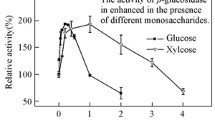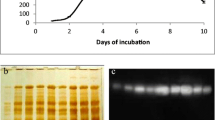Abstract
Glucosinolates, natural compounds found in Brassicaceae, can easily be transformed into desulfo-glucosinolates by action of Helix pomatia sulfatase. The recombinant β-O-glucosidase from Caldocellum saccharolyticum does not catalyse glucosinolate degradation but can hydrolyse desulfo-glucosinolates (thio-d-glucosidic substrates) to produce the corresponding pure nitriles, including valuable homochiral representatives.
Similar content being viewed by others
References
Ettlinger M,Lundeen A (1956) The structure of sinigrin and sinalbin; an enzymatic rearrangement. J. Am. Chem. Soc. 78: 4172–4173.
Fenwick RG,Heaney RK,Mullin W (1983) Glucosinolates and their breakdown products in food and food plants. CRC Crit. Rev. Food Sci. Nutr. 18: 123–201.
Kirk L,Mustakas E,Grifin J,Booth A (1971) Crambe seed processing. Decomposition of glucosinolates (thioglucosides) with chemical additives. J. Am. Oil Chem. Soc. 48: 845–850.
Larsen P (1981) Glucosinolates. In: Stumpf P,Conn E, eds. The Biochemistry of Plants. A Comprehensive Treatise, Vol. 7. New York: Academic Press, pp. 501–525.
Leoni O,Iori R,Haddoum T,Marlier M,Wathelet J-P,Rollin P,Palmieri S (1998) Approach to the use of immobilised sulfatase for analytical purposes and for the production of desulfoglucosinolates. Ind. Crops Prod. 7: 335–343.
Palmieri S,Iori R,Joseph B,Rollin P (1993) Myrosinase and hydrolytic degradation of natural and synthetic glucosinolates. Colloque Glucosinolates ‘10 Années de Recherche’ CETIOM Ardon, France, 13–14 January 1993, pp. 57–62.
Plant A,Oliver J,Patchett M,Daniel R,Morgan H (1988) Stability and substrate specificity of a beta-glucosidase from the thermophilic bacterium Tp8 cloned into Escherichia coli. Arch. Biochem. Biophys. 262: 181–188.
Thies W (1979) Detection and utilisation of a glucosinolate sulfohydrolase in the edible snail Helix pomatia. Naturwissenschaften 66: 364–365.
Thies W (1988) Isolation of sinigrin and glucotropaeolin from cruciferous seeds. Fat Sci. Technol. 8: 311–314.
Vangheesdaele G,Fournier N (1977) La dégradation des thioglucosides par les sels de cuivre (application au dosage de la sinigrine dans les graines de moutarde). Ann. Technol. Agric. 26: 499–510.
Viaud M-C,Rollin P,Latxague L,Gardrat C (1992) Synthethic studies on indole glucosinolates. Part 1. Synthesis of glucobrassicin and its 4–and 5–methoxy derivatives. J. Chem. Res. 207: 1669–1681.
Visentin M,Tava A,Iori R,Palmieri S (1992) Isolation and identification of trans-4–(methylthio)-3–butenyl glucosinolate from radish root (Raphanus sativus). J. Agric. Food Chem. 40: 1687–1691.
Author information
Authors and Affiliations
Rights and permissions
About this article
Cite this article
Wathelet, JP., Iori, R., Leoni, O. et al. A recombinant β-O-glucosidase from Caldocellum saccharolyticum to hydrolyse desulfo-glucosinolates. Biotechnology Letters 23, 443–446 (2001). https://doi.org/10.1023/A:1010322322867
Issue Date:
DOI: https://doi.org/10.1023/A:1010322322867




